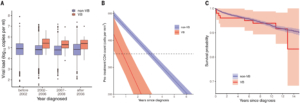A highly virulent variant of HIV-1 circulating
Evolving virulence in HIV
Changes in viral load and CD4+ T cell decline are expected signals of HIV evolution. By examining data from well-characterized European cohorts, Wymant et al. report an exceptionally virulent subtype of HIV that has been circulating in the Netherlands for several years (see the Perspective by Wertheim). More than one hundred individuals infected with a characteristic subtype B lineage of HIV-1 were found who experienced double the rate of CD4+ cell count declines than expected. By the time they were diagnosed, these individuals were vulnerable to developing AIDS within 2 to 3 years. This virus lineage, which has apparently arisen de novo since around the millennium, shows extensive change across the genome affecting almost 300 amino acids, which makes it hard to discern the mechanism for elevated virulence. —CA
Abstract
We discovered a highly virulent variant of subtype-B HIV-1 in the Netherlands. One hundred nine individuals with this variant had a 0.54 to 0.74 log10 increase (i.e., a ~3.5-fold to 5.5-fold increase) in viral load compared with, and exhibited CD4 cell decline twice as fast as, 6604 individuals with other subtype-B strains. Without treatment, advanced HIV—CD4 cell counts below 350 cells per cubic millimeter, with long-term clinical consequences—is expected to be reached, on average, 9 months after diagnosis for individuals in their thirties with this variant. Age, sex, suspected mode of transmission, and place of birth for the aforementioned 109 individuals were typical for HIV-positive people in the Netherlands, which suggests that the increased virulence is attributable to the viral strain. Genetic sequence analysis suggests that this variant arose in the 1990s from de novo mutation, not recombination, with increased transmissibility and an unfamiliar molecular mechanism of virulence.

